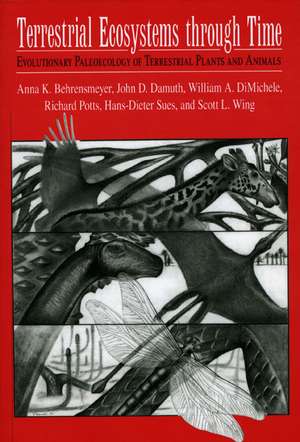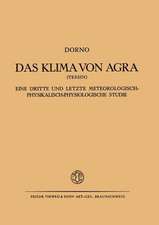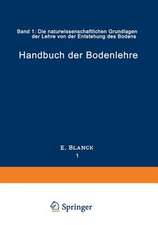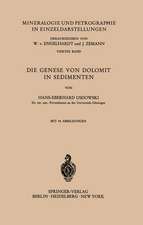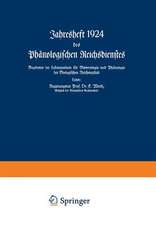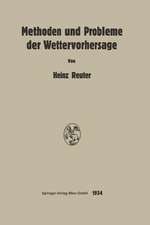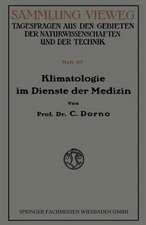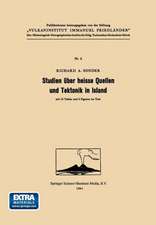Terrestrial Ecosystems Through Time: Evolutionary Paleoecology of Terrestrial Plants and Animals
Autor Anna K. Behrensmeyer, John D. Damuth, William A. DiMichele, Richard Pottsen Limba Engleză Paperback – 31 mai 1992
Breathtaking in scope, this is the first survey of the entire
ecological history of life on land—from the earliest traces
of terrestrial organisms over 400 million years ago to the
beginning of human agriculture. By providing myriad insights
into the unique ecological information contained in the
fossil record, it establishes a new and ambitious basis for
the study of evolutionary paleoecology of land ecosystems.
A joint undertaking of the Evolution of Terrestrial
Ecosystems Consortium at the National Museum of Natural
History, Smithsonian Institution, and twenty-six additional
researchers, this book begins with four chapters that lay out
the theoretical background and methodology of the science of
evolutionary paleoecology. Included are a comprehensive
review of the taphonomy and paleoenvironmental settings of
fossil deposits as well as guidelines for developing
ecological characterizations of extinct organisms and the
communities in which they lived. The remaining three
chapters treat the history of terrestrial ecosystems through
geological time, emphasizing how ecological interactions have
changed, the rate and tempo of ecosystem change, the role of
exogenous "forcing factors" in generating ecological change,
and the effect of ecological factors on the evolution of
biological diversity.
The six principal authors of this volume are all associated
with the Evolution of Terrestrial Ecosystems program at the
National Museum of Natural History, Smithsonian Institution.
ecological history of life on land—from the earliest traces
of terrestrial organisms over 400 million years ago to the
beginning of human agriculture. By providing myriad insights
into the unique ecological information contained in the
fossil record, it establishes a new and ambitious basis for
the study of evolutionary paleoecology of land ecosystems.
A joint undertaking of the Evolution of Terrestrial
Ecosystems Consortium at the National Museum of Natural
History, Smithsonian Institution, and twenty-six additional
researchers, this book begins with four chapters that lay out
the theoretical background and methodology of the science of
evolutionary paleoecology. Included are a comprehensive
review of the taphonomy and paleoenvironmental settings of
fossil deposits as well as guidelines for developing
ecological characterizations of extinct organisms and the
communities in which they lived. The remaining three
chapters treat the history of terrestrial ecosystems through
geological time, emphasizing how ecological interactions have
changed, the rate and tempo of ecosystem change, the role of
exogenous "forcing factors" in generating ecological change,
and the effect of ecological factors on the evolution of
biological diversity.
The six principal authors of this volume are all associated
with the Evolution of Terrestrial Ecosystems program at the
National Museum of Natural History, Smithsonian Institution.
Preț: 495.83 lei
Nou
Puncte Express: 744
Preț estimativ în valută:
94.89€ • 98.03$ • 78.97£
94.89€ • 98.03$ • 78.97£
Carte tipărită la comandă
Livrare economică 25 martie-08 aprilie
Preluare comenzi: 021 569.72.76
Specificații
ISBN-13: 9780226041551
ISBN-10: 0226041557
Pagini: 588
Ilustrații: 31 line drawings, 9 maps, 7 haltones, 21 tables
Dimensiuni: 152 x 229 x 38 mm
Greutate: 0.78 kg
Ediția:1
Editura: University of Chicago Press
Colecția University of Chicago Press
ISBN-10: 0226041557
Pagini: 588
Ilustrații: 31 line drawings, 9 maps, 7 haltones, 21 tables
Dimensiuni: 152 x 229 x 38 mm
Greutate: 0.78 kg
Ediția:1
Editura: University of Chicago Press
Colecția University of Chicago Press
Cuprins
List of Tables and Figures
Preface
List of Conference Participants
1. Evolutionary Paleoecology
1. Introduction
2. The Methods of Evolutionary Paleoecology
2.1. Taphonomy
2.2. Ecological Characterization of Extinct Species
2.3. Ecological Characterization of Past Communities: Synchronic Features
2.4. Ecological Characterization of Past Communities: Diachronic Features
3. Conclusion
References
2. Paleoenvironmental Contexts and Taphonomic Modes
1. Introduction
2. Coastal Environments
2.1. Offshore
2.2. Beaches
2.3. Lagoons and Other Back-Barrier Settings
2.4. Estuaries
3. Fluvial and Deltaic Environments
3.1. Channels: Basal Lags and Bars
3.2. Abandoned Channel Fills
3.3. Levees
3.4. Floodplains
3.5. Crevasse Splays
3.6. Interdistributary Bays
4. Lacustrine Environments
4.1. Oxygen-Depleted Large Lakes
4.2. Oxygen-Depleted Small, Deep Lakes
4.3. Oxygen-Depleted Small, Shallow Lakes
4.4. Oxygenated Large Lakes
4.5. Oxygenated Small Lakes
5. Volcanigenic Environments
5.1. Explosive Events
5.2. Primary Airfall
5.3. Lacustrine Volcaniclastics
6. Eolian Environments
6.1. Dunes and Interdunes
6.2. Loess
7. Other Contexts for Organic Preservation
7.1. Traps
7.2. Burrows
7.3. Feces and Regurgitates
7.4. Middens
7.5. Archeological Accumulations
7.6. Springs
7.7. Peat-Forming Environments
7.8. Charcoal Deposits
7.9. Mud Slides and Flash Floods
8. Time and Space Resolution in the Fossil Record
8.1. Time Resolution and Completeness
8.2. Methods for Assessing Time Resolution
8.3. Spatial Resolution
8.4. Resolution in the Taphonomic Modes
9. Change through Time in the Taphonomic Modes
9.1. Effects of Area
9.2. Consequence of Environmental Change
9.3. Changes in Taphonomic Processes
10. Conclusion
References
3. Ecological Characteristics of Fossil Plants
1. Introduction
2. Autecology of Extinct Plants
2.1. Inferring Autecology from Functional Morphology
2.2. Inferring Autecology from Living Relatives
2.3. Inferring Autecology from Sedimentary Environment
3. Methods of Sampling and Analysis at the Community Level
3.1. Sampling Compression-Impression Assemblages
3.2. Sampling Permineralized Peats
3.3. Sampling Microfossils
3.4. Taphonomy and Effective Sampling Radius
3.5. Analytical Methods
4. Synecology of Extinct Vegetation
4.1. Synchronic Features of Extinct Vegetation
5. Comparison of Communities across Time
5.1. Ecological Interpretation of Morphology at the Community Level
5.2. Ecological Categories
6. Conclusion
References
4. Taxon-Free Characterization of Animal Communities
1. Introduction: Taxon-Free Characterizations
2. One Approach to Taxon-Free Characterization
2.1. Ecomorphology and Ecological Types
2.2. Functional Morphology and Autecological Inference
2.3. Continuous versus Category Variables
2.4. A Basic Set of Ecological Variables and Categories
2.5. Analyses Using Ecological Types
3. Complementary Approaches and Higher-Level Inferences
References
5. Paleozoic Terrestrial Ecosystems
1. Introduction
2. The Ordovician
3. The Silurian
4. The Early to Middle Devonian
4.1. Plants
4.2. Animals
4.3. Synthesis
5. The Late Devonian to Early Carboniferous
5.1. Plants
5.2. Animals
5.3. Synthesis
6. The Late Carboniferous: Westphalian and Stephanian
6.1. Plants
6.2. Invertebrates
6.3. Vertebrates
6.4. Synthesis
7. The Permian
7.1. Plants
7.2. Arthropods
7.3. Vertebrates
7.4. Synthesis
8. Paleozoic Summary and Discussion
8.1. Ecosystem Stability and Persistence
8.2. Conclusions
References
6. Mesozoic and Early Cenozoic Terrestrial Ecosystems
1. Introduction
2. Triassic Biotas
2.1. Triassic Vegetation of Laurasia
2.2. Triassic Vegetation of Gondwana
2.3. Triassic Faunas
2.4. Triassic Ecological and Evolutionary Trends
3. Jurassic Biotas
3.1. Jurassic Vegetation
3.2. Jurassic Faunas
3.3. Jurassic Ecological and Evolutionary Trends
4. Cretaceous Biotas
4.1. Early Cretaceous Vegetation
4.2. Late Cretaceous Vegetation
4.3. Cretaceous Faunas
4.4. Cretaceous Ecological and Evolutionary Trends
5. Paleogene Biotas
5.1. The K/T Boundary and Earliest Paleocene Vegetation
5.2. Paleocene-Eocene Vegetation
5.3. Paleogene Faunas
5.4. Paleogene Ecological and Evolutionary Trends
6. Mesozoic and Early Cenozoic Ecological Changes
6.1. Changes in Herbivory
6.2. Changes in Dispersal
6.3. Changes in Pollination
6.4. Changes in Plant Competition
7. Discussion and Conclusion
7.1. Precipitation, Diversity Gradients, and Vegetational Structure
7.2. Long-Term Effects of Precipitation on Plant-Herbivore Dynamics
7.3. Coevolutionary Limits on Vegetational Richness
7.4. Comparative Paleoecology of Mass Extinctions
7.5. Ecological Context and Evolutionary Opportunity
References
7. Late Cenozoic Terrestrial Ecosystems
1. Introduction
2. Synopsis of Late Cenozoic Ecological History
2.1. Overview of Environmental Change
2.2. Ecological Trends of the Late Cenozoic
2.3. Diversity Patterns
3. Ecological Histories by Continent
3.1. North America
3.2. South America
3.3. Africa
3.4. Eurasia
3.5. Australia
4. Patterns and Processes of Ecological Change
4.1. Overall Processes of Biotic Change
4.2. Relationships between Climatic and Ecological Changes
4.3. Meagan Extinctions
4.4. Post-Pleistocene Impact of Humans
5. Conclusions
References
Appendix: Paleozoic Geologic Time Scale
Taxonomic Name Index
Subject Index
Preface
List of Conference Participants
1. Evolutionary Paleoecology
1. Introduction
2. The Methods of Evolutionary Paleoecology
2.1. Taphonomy
2.2. Ecological Characterization of Extinct Species
2.3. Ecological Characterization of Past Communities: Synchronic Features
2.4. Ecological Characterization of Past Communities: Diachronic Features
3. Conclusion
References
2. Paleoenvironmental Contexts and Taphonomic Modes
1. Introduction
2. Coastal Environments
2.1. Offshore
2.2. Beaches
2.3. Lagoons and Other Back-Barrier Settings
2.4. Estuaries
3. Fluvial and Deltaic Environments
3.1. Channels: Basal Lags and Bars
3.2. Abandoned Channel Fills
3.3. Levees
3.4. Floodplains
3.5. Crevasse Splays
3.6. Interdistributary Bays
4. Lacustrine Environments
4.1. Oxygen-Depleted Large Lakes
4.2. Oxygen-Depleted Small, Deep Lakes
4.3. Oxygen-Depleted Small, Shallow Lakes
4.4. Oxygenated Large Lakes
4.5. Oxygenated Small Lakes
5. Volcanigenic Environments
5.1. Explosive Events
5.2. Primary Airfall
5.3. Lacustrine Volcaniclastics
6. Eolian Environments
6.1. Dunes and Interdunes
6.2. Loess
7. Other Contexts for Organic Preservation
7.1. Traps
7.2. Burrows
7.3. Feces and Regurgitates
7.4. Middens
7.5. Archeological Accumulations
7.6. Springs
7.7. Peat-Forming Environments
7.8. Charcoal Deposits
7.9. Mud Slides and Flash Floods
8. Time and Space Resolution in the Fossil Record
8.1. Time Resolution and Completeness
8.2. Methods for Assessing Time Resolution
8.3. Spatial Resolution
8.4. Resolution in the Taphonomic Modes
9. Change through Time in the Taphonomic Modes
9.1. Effects of Area
9.2. Consequence of Environmental Change
9.3. Changes in Taphonomic Processes
10. Conclusion
References
3. Ecological Characteristics of Fossil Plants
1. Introduction
2. Autecology of Extinct Plants
2.1. Inferring Autecology from Functional Morphology
2.2. Inferring Autecology from Living Relatives
2.3. Inferring Autecology from Sedimentary Environment
3. Methods of Sampling and Analysis at the Community Level
3.1. Sampling Compression-Impression Assemblages
3.2. Sampling Permineralized Peats
3.3. Sampling Microfossils
3.4. Taphonomy and Effective Sampling Radius
3.5. Analytical Methods
4. Synecology of Extinct Vegetation
4.1. Synchronic Features of Extinct Vegetation
5. Comparison of Communities across Time
5.1. Ecological Interpretation of Morphology at the Community Level
5.2. Ecological Categories
6. Conclusion
References
4. Taxon-Free Characterization of Animal Communities
1. Introduction: Taxon-Free Characterizations
2. One Approach to Taxon-Free Characterization
2.1. Ecomorphology and Ecological Types
2.2. Functional Morphology and Autecological Inference
2.3. Continuous versus Category Variables
2.4. A Basic Set of Ecological Variables and Categories
2.5. Analyses Using Ecological Types
3. Complementary Approaches and Higher-Level Inferences
References
5. Paleozoic Terrestrial Ecosystems
1. Introduction
2. The Ordovician
3. The Silurian
4. The Early to Middle Devonian
4.1. Plants
4.2. Animals
4.3. Synthesis
5. The Late Devonian to Early Carboniferous
5.1. Plants
5.2. Animals
5.3. Synthesis
6. The Late Carboniferous: Westphalian and Stephanian
6.1. Plants
6.2. Invertebrates
6.3. Vertebrates
6.4. Synthesis
7. The Permian
7.1. Plants
7.2. Arthropods
7.3. Vertebrates
7.4. Synthesis
8. Paleozoic Summary and Discussion
8.1. Ecosystem Stability and Persistence
8.2. Conclusions
References
6. Mesozoic and Early Cenozoic Terrestrial Ecosystems
1. Introduction
2. Triassic Biotas
2.1. Triassic Vegetation of Laurasia
2.2. Triassic Vegetation of Gondwana
2.3. Triassic Faunas
2.4. Triassic Ecological and Evolutionary Trends
3. Jurassic Biotas
3.1. Jurassic Vegetation
3.2. Jurassic Faunas
3.3. Jurassic Ecological and Evolutionary Trends
4. Cretaceous Biotas
4.1. Early Cretaceous Vegetation
4.2. Late Cretaceous Vegetation
4.3. Cretaceous Faunas
4.4. Cretaceous Ecological and Evolutionary Trends
5. Paleogene Biotas
5.1. The K/T Boundary and Earliest Paleocene Vegetation
5.2. Paleocene-Eocene Vegetation
5.3. Paleogene Faunas
5.4. Paleogene Ecological and Evolutionary Trends
6. Mesozoic and Early Cenozoic Ecological Changes
6.1. Changes in Herbivory
6.2. Changes in Dispersal
6.3. Changes in Pollination
6.4. Changes in Plant Competition
7. Discussion and Conclusion
7.1. Precipitation, Diversity Gradients, and Vegetational Structure
7.2. Long-Term Effects of Precipitation on Plant-Herbivore Dynamics
7.3. Coevolutionary Limits on Vegetational Richness
7.4. Comparative Paleoecology of Mass Extinctions
7.5. Ecological Context and Evolutionary Opportunity
References
7. Late Cenozoic Terrestrial Ecosystems
1. Introduction
2. Synopsis of Late Cenozoic Ecological History
2.1. Overview of Environmental Change
2.2. Ecological Trends of the Late Cenozoic
2.3. Diversity Patterns
3. Ecological Histories by Continent
3.1. North America
3.2. South America
3.3. Africa
3.4. Eurasia
3.5. Australia
4. Patterns and Processes of Ecological Change
4.1. Overall Processes of Biotic Change
4.2. Relationships between Climatic and Ecological Changes
4.3. Meagan Extinctions
4.4. Post-Pleistocene Impact of Humans
5. Conclusions
References
Appendix: Paleozoic Geologic Time Scale
Taxonomic Name Index
Subject Index
